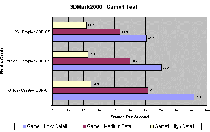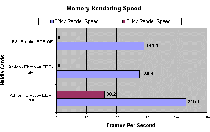|
3Dmark2000:
3Dmark2000
is much more the benchmark for gamers because it's based on
a game engine itself. Another thing to note is that the '3Dmark'
score is different from '3Dmark99', very different. So don't
judge just because the marks are far lower than you might be
used to, they are actually higher.

Game1
is a helicopter that flies over an immaculately detailed 3D
landscape covered with trees, lakes and various military vehicles.
This is easily the most demanding test when in 'High Detail',
the landscape turns into a dense forest, which puts even the
most sophisticated systems through their paces. As such the
GeForce fairs pretty well, this is the point at which you notice
little difference between the P3 and K7 systems on the SDR.
The
reason is the whole point for the GeForce existing, the fact
that all the complex 3D is being carried out on the card itself
and not the CPU. However the instructions that are done on the
CPU obviously allow the Athlon to push that little bit further
ahead. What's really interesting is that in 'High Detail', the
DDR board is barely ahead of the SDR; this is because the amount
of textures has changed little compared to the Geometry. Time
to investigate the memory speeds a little more:

The
most obvious thing is that the SDR card with its single memory
transfers can't do 64Mbs of textures, where as the DDR with
its Dual pipes can. So obviously the DDR is fast outstripping
our now humbled SDR, still that aside and the SDR's speeds remain
impressive. It's now quite easy to see that DDR cards are only
really useful for games with a lot of textures or that you run
in super high resolutions. Remember the SDR card comes with
32mbs of RAM, it's unlikely many games will require more than
that so it begins to make you wonder what the point of the DDR
is so early on in the GeForces life? We ran a full 3Dmark2000
benchmark and decided to check out the '3Dmark' scores:
Next
>>
<<
Previous
[an error occurred while processing this directive]
|